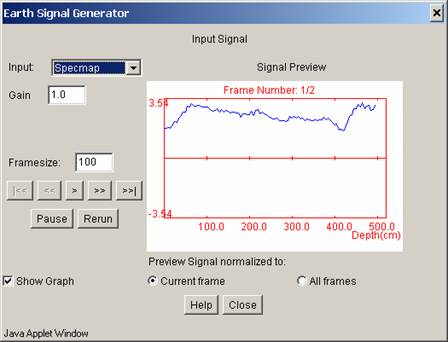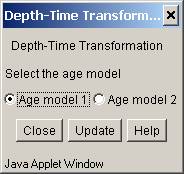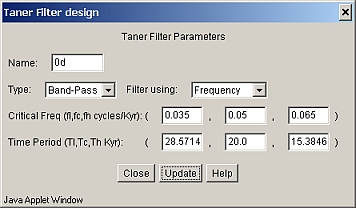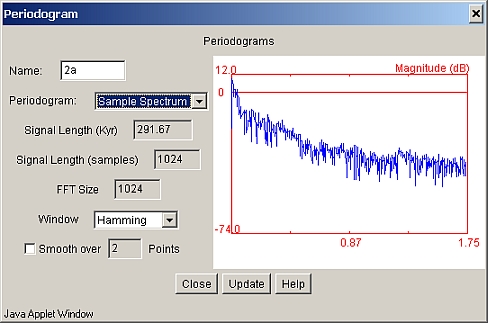The major functions available in JDSP/ESE along with their brief descriptions are given in this section. Currently available functions are the Earth Signals block, Depth-Time Transformation, Interpolation & Re-Sampling, Window, Taner filter, Spectrogram. Other functions that will soon become a part of J-DSP/ESE are Gaussian filters, that form a major part of time series analysis and spectral functions (including multi-taper method and red-noise fitting). Please continue checking the page for updates. |
 |
Earth Signals Block |
| J-DSP Earth Signals block has in-built Earth system signals that correspond to samples collected from the natural phenomena. Three signals currently available are Gaussian SPECMAP (RC11-120 d180 series), non-Gaussian Lake Baikal (percent Biosilica) and binary Trubi Marls (lithologic ranks) data sets. The Earth Signal Generator has the capability to output the signals frame-by-frame at the user-defined frame length or as a whole. When using frame-by-frame data, the user has the option to move to any frame using the buttons for playback control. There is also an intuitive panel that shows a preview of the data of the current frame. |
 |
| Figure 1. Earth signal generator |
 |
Depth-Time Transformation |
| Typically the data obtained from Earth signals are scaled in depth; each depth corresponds to a particular time in the actual time series. Depth-time transformation uses age models that relate the depth to a particular time of occurrence. J-DSP/ESE converts the depth scales to time scales and the output of the block carries the data in time scale. |
 |
| Figure 2. Depth-Time transformation using age models |
 |
Interpolation & Re-sampling |
| To apply most signal processing techniques, we need the time series to be uniformly sampled. In this block, we perform interpolation and re-sampling to obtain uniformly sampled time series. Right now, the block can perform linear or quadratic interpolation. The block also re-samples the data uniformly based on the number of samples or the sampling interval specified by the user. |
 |
| Figure 3. Interpolation & Re-sampling of time series |
 |
Window |
| The re-sampled data can be passed through the window block where it is multiplied by a tapered window. Apart from the windows in the standard J-DSP version, two new windows, Gaussian and Tukey, which are extensively used by geoscientists, have been incorporated in the window block. |

|
| Figure 4. Windowing the data |
 |
Taner Filter |
| Taner lowpass and bandpass functions are incorporated into the Taner filter block. The filter retrieves the sampling interval from the previous block and filters the incoming signal. The critical frequencies can be specified in frequency units or time (periodicity) units. |

|
| Figure 5. Taner Filter |
 |
Periodogram |
| This block computes the periodogram of the input signal using the window specified by the user. The length of the signal and samples are retrieved from the previous blocks and an option to smooth the periodogram is also provided. The output from the periodogram can be viewed in a plot block so that it can be zoomed to view the details. |

|
| Figure 6. Periodogram |
 |
Time Frequency Analysis (Spectrogram) |
| Time frequency analysis is performed using the spectrogram block. The user inputs are the window type, window length and the number of FFT points for calculating the spectrum. The block automatically calculates the window size in samples and it also retrieves the sampling interval from the previous block connected to it. The graph displayed can be zoomed in by choosing "Manual" from the Axis drop-down menu. Figure 7 shows the spectrogram of the SPECMAP dataset that was converted to time and uniformly interpolated to 1024 points. |

|
| Figure 7. Spectrogram |
| |






